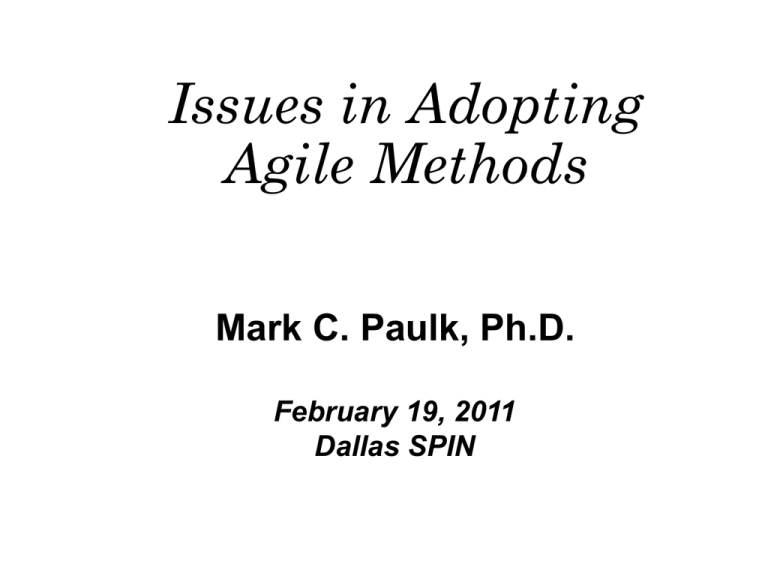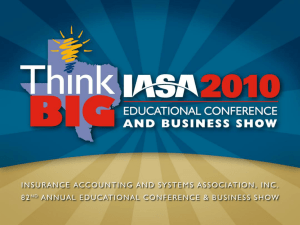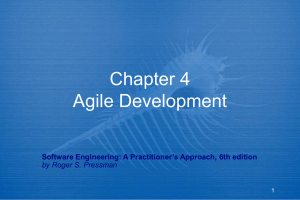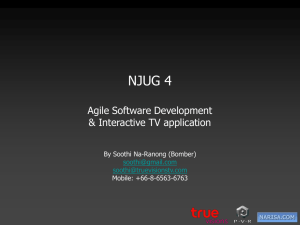agile - Dallas Fort/Worth - Association for Software Engineering
advertisement

Issues in Adopting Agile Methods Mark C. Paulk, Ph.D. February 19, 2011 Dallas SPIN Important Agile Methods Extreme Programming (XP) Scrum Crystal Light Methods, specifically Crystal Clear Feature Driven Development (FDD) Adaptive Software Development Dynamic Solutions Delivery Model (DSDM) Lean Development 2 The Agile Manifesto “We are uncovering better ways of developing software by doing it and helping others do it. Through this work we have come to value: • individuals and interactions over processes and tools • working software over comprehensive documentation • customer collaboration over contract negotiation • responding to change over following a plan That is, while there is value on the items on the right, we value the items on the left more.” http://www.agilealliance.org 3 Rakitin’s Translation Individuals and interactions over processes and tools. Talking to people instead of using a process gives us the freedom to do whatever we want. Working software over comprehensive documentation. We want to spend all our time coding. Remember, real programmers don’t write documentation. Customer collaboration over contract negotiation. Haggling over the details is merely a distraction from the real work of coding. We’ll work out the details once we deliver something. Responding to change over following a plan. Following a plan implies we have to think about the problem and how we might actually solve it. Why would we want to do that when we could be coding? S.R. Rakitin, “Manifesto Elicits Cynicism,” IEEE Computer, December 2001, p. 7. 4 Why Embrace Agility? Agility helps us manage change and uncertainty… Change does not yield to rational analysis; responding to change requires a leap of faith… There is never one obvious option, but a multitude of options that seem reasonable. There is never enough information, and the information in hand is often contradictory. Change creates ambiguity, uncertainty, doubt, and indecision that lead to floundering. J. Highsmith, “Agile Leadership: Focus and Clarity,” Agile Product & Project Management E-Mail Advisor, 3 June 2010. 5 Principles of Agile Software Development A. Cockburn, “Learning From Agile Software Development” 1) 2) 3) 4) Different projects need different methodology trade-offs. A little methodology does a lot of good; after that, weight is costly. Larger teams need more communication elements. Projects dealing with greater potential damage need more validation elements. 5) Formality, process, and documentation are not substitutes for discipline, skill, and understanding. 6) Interactive, face-to-face communication is the cheapest and fastest channel for exchanging information. 7) Increased communication and feedback reduces the need for intermediate work products. 8) Concurrent and serial development exchange development cost for speed and flexibility. 9) Efficiency is expendable in non-bottleneck activities. 10)Sweet spots speed development. 6 Six Sweet Spots Dedicated developers Experienced developers Small co-located team Automated regression tests Easy access to users Short increments and frequent delivery to real users 7 Agile vs Plan-Driven Tradeoffs Boehm and Turner, Balancing Agility and Discipline: A Guide for the Perplexed, 2004. 8 S.W. Ambler, “Agile Adoption Rate Survey Results: February 2008,” <URL: http://www.ambysoft.com/surveys/agileFebruary2008.html> 9 S.W. Ambler, “Agile Adoption Rate Survey Results: February 2008” <URL: http://www.ambysoft.com/surveys/agileFebruary2008.html> 10 Extreme Programming Practices Planning game Pair programming Small releases Collective (code) ownership Metaphor Continuous integration Simple design 40-hour week • (sustainable pace) Testing • (test-driven development) • (customer tests) On-site customer • (whole team) Refactoring • (design improvement) Coding standard Kent Beck, Extreme Programming Explained: Embrace Change, 1999. (http://www.xprogramming.com/xpmag/whatisxp.htm) 11 The 2004 XP Practices Primary Practices • Sit together • Whole team • Informative workspace • Energized work • Pair programming • Stories • Weekly cycle • Quarterly cycle • Slack • Ten-minute build • Continuous integration • Test-first programming • Incremental design Corollary Practices • Real customer involvement • Incremental deployment • Team continuity • Shrinking teams • Root-cause analysis • Shared code • Code and tests • Single code base • Daily deployment • Negotiated scope contract • Pay-per-use K. Beck and C. Andres, Extreme Programming Explained: Embrace Change, 2nd Edition, 2004. 12 Scrum’s 3 + 3 + 3 Three roles • Product Owner • ScrumMaster • Development Team Three ceremonies • Sprint Planning Meeting • Daily Scrum Meeting • Sprint Review Meeting Three artifacts • Product Backlog • Sprint Backlog • Burndown Chart 13 No Silver Bullet Scrum will not solve your problems. Scrum will make your problems visible. You will have to solve your problems. 14 Potential Barriers to Agile Skepticism about agile intent a la Rakitin Doubts about agile implementation - as intended by the agile gurus Concerns about impact on existing jobs - Project managers, business analysts, product line owners, … Concerns about impact on customer-supplier relationships - Custom software development vs software products The normal resistance to change, diffusion of innovation… 15 Three Important (Empirical) Questions How has using agile methods helped projects succeed or fail in your company? - What’s usefully different about agile? How do projects measure business success in your company? - predictability, short cycle time, customer satisfaction, low cost, innovation, … What factors affected adoption of agile methods? - What caused you to consider agile? - What barriers hindered adoption? - What tailorings were necessary to fit your culture? 16 Scrum Practice Effectiveness The Scrum method in principle should be used without much variation – significant variation probably indicates a “ScrumBut” implementation Practices that are perceived as working will continue to be used… Were any Scrum practices perceived as not being feasible? Did any Scrum practices not work well when tried? 17 Measuring Business Success Does the project have a “product vision” that characterizes success? How does the project measure success? • financial / market (profit, market share) • quickly responding to changing customer needs • cost and schedule drivers • quality • customer satisfaction / delight • innovation (building for the future) 18 Factors Affecting Adoption Some general diffusion of innovation / change management / marketing / technology adoption / process improvement factor issues • sponsorship – addressing business problems • resistance to change • • • • - We need a requirements specification. shelfware (facades) training, user groups, conferences scope of piloting / adoption politics, responsibility, accountability Some cultural issues • power and control • uncertainty (when will we be done?) • confrontation vs compromise • risk aversion 19 Tacit vs Explicit Knowledge “The difference between agile methods and the Unified Process is knowledge management – agile is tacit, UP is explicit.” Ivar Jacobson, Software Engineering Conference (Russia), 27-28 October 2005. 20 Architecture Breakers For very large systems, our Pareto analysis of rework costs at TRW indicated that the 20% of the problems causing 80% of the rework came largely from “architecture-breakers.” Over-focus on early results in large systems can lead to major rework when the architecture doesn’t scale up. B. Boehm, “Get Ready for Agile Methods, With Care,” IEEE Computer, January 2002. 21 Barriers to the Success of Agile A customer who insists on the big specification… A culture that requires long hours to prove commitment… Projects that are too big (more than about ten programmers)… An environment with a long time to gain feedback (e.g., realistically test the software)… The wrong physical environment (e.g., team members on different floors, not co-located)… We do “agile”, just not most / any of the practices… 22 Cultural Misfits (Using the DoD as an Example…) Regulatory requirements for a level playing field raise challenges for evolutionary and incremental development… The need by the contracts officer for a requirements specification… Progress payments defined from a waterfall mentality… Barriers – regulatory and cultural – to a collaborative customer relationship… Protests from competitors… 23 Scrum Adoption Research Plans Survey of Scrum projects Interviews and case studies of selected projects Confirming / testing “what everyone knows” • Scrum practices, variations, and associated practices • business value of Scrum • factors affecting Scrum adoption 24 Questions and Answers 25 Contact Information Dr. Mark C. Paulk Institute for Software Research Carnegie Mellon University Wean Hall 5101 5000 Forbes Avenue Pittsburgh, PA 15213 USA Email: mcp@cs.cmu.edu or Mark.Paulk@ieee.org Web: http://www.cs.cmu.edu/~mcp/ 26









